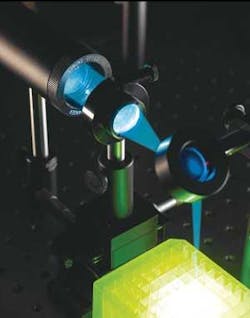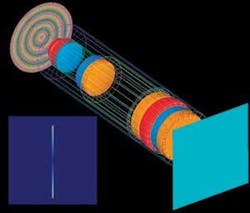Souping up optics with design and simulation software
When a trio of engineers at Rensselaer Polytechnic Institute (Troy, NY), wanted to make an optical microscope that “looked” across a sample without moving it, they soon recognized that optics modeling and analysis software would be necessary to help overcome the inherent mechanical and optical challenges. A range of factors limit the shape-forming capabilities of the deformable MEMS (microelectromechanical systems) mirrors that form the basis of the adaptive scanning optical microscope (ASOM) created by the team–consisting of Yves Bellouard, now an assistant professor of micro/nano-scale engineering at Eindhoven University of Technology in The Netherlands; Benjamin Potsaid, now a research scientist at Thorlabs (Newton, NJ); and John Wen, professor in the department of electrical, computer, and systems engineering at RPI. As Potsaid says, “By simulating the aperture sizes and shape-forming capabilities of several different deformable-mirror technologies early on in the ASOM development, we were able to better understand the mirror technologies in order to select an appropriate device.” For such simulations, says Wen, the team used “ZEMAX (ZEMAX Development Corp.; Bellevue, WA) optical design software combined with custom-written C code, commercially available finite-element-analysis structural simulation code, and MATLAB (The MathWorks; Natick, MA).” He adds, “This allowed us to not only design and simulate the optical aspects of the ASOM, but also the electrostatic-mechanical behavior of the MEMS deformable mirror and its impact on the overall optical performance of the system.”
Software is “absolutely essential,” said Michael Ganser, head of department within R&D at Leica Microsystems CMS (Wetzlar, Germany), when asked about the benefits of using software to design optics. “In the past, people used simple calculators to find the optimum design, but not since the 1970s. Since then, the complexity has increased substantially, and that has been driven for many years by the development of new software tools.”
That complexity has extended beyond the bounds of optics-design and simulation software, too. For instance, the standard edition of Breault Research Organization’s (BRO, Tucson) ASAP package includes a license for SolidWorks’ (Concord, MA) Parts Only 3D Modeling Engine–which is a 3D mechanical CAD environment optimized for use with ASAP. The SolidWorks module lets you write ASAP geometry files from within SolidWorks, import XML files, or use BRO’s smartIGES system to import system models from any other CAD package–while retaining the benefits of working within an optics-design system.
Commercial, custom, and competitive advantage
Like the RPI team, many designers mix off-the-shelf products with custom ones. Jeremy Govier, director of design services at Edmund Optics (Tucson, AZ), says, “We use a variety of off-the-shelf packages, but we also create lots of macros and program in those packages to customize them.” Nonetheless, the required customization does not take much time. “We write maybe 10 things a year,” says Govier, “and they tend to be simple, but we use them a lot.”
As an example, Edmund designers use ZEMAX and Code V (Optical Research Associates; Pasadena, CA). “Both have strengths and weaknesses, so we use both to get the best solutions for optimization and analysis,” says Govier. To track stray light in a design, Govier and his colleagues use FRED Optimum (Photon Engineering; Tucson). “We are exceedingly happy with FRED,” Govier says. “It is very easy to use and very powerful. It has made some significant changes in the efficiency of how we design.”
Edmund scientists used all of this software–Code V, ZEMAX, and FRED–to improve lenses for detecting fluorescence. “In many biomedical applications, the fluorescent signal is very low compared to the source and unwanted light washes out the signal,” says Govier. “So we use lots of analysis to see where the light comes from and where it goes.”
Scientists at Leica also use ZEMAX, but Ganser adds, “We do not use it specifically to design objectives. Instead, we use ZEMAX for things like simulating multi-configurations or to design illumination.” For the optics, scientists at Leica turn to proprietary code.
Whatever approach they take, designers are often very secretive about their use of optics modeling and analysis software. A spokesperson for one large optical company, for example, said that it did rely heavily on software, but didn’t want to say anything–not even a word–about it. In fact, this company did not want to even be identified.
Still an art
As optical-design software continues to improve, microscope makers could put too much emphasis on the results from a program. Govier says, “The ease of use of software has increased exponentially over the past decade, so many designers are getting the idea that the software does the work–hit a button and a lens comes out.”
The software does provide a quick solution, but it might only involve the physics behind the optics. “This can lead to designs that are too difficult to manufacture or ones that are too sensitive to tolerancing,” Govier says. “Software might not optimize for cost or manufacturing.” So the designer remains a key element in the process.
Ganser also points out the importance of tolerancing. He says, “The optics design itself and finding an optimum configuration is the easy part. We can do that mathematically, but the resulting designs usually would be so sensitive to tolerances that you cannot manufacture them.” Consequently, Leica’s proprietary software deals with interactions between subgroups–or separated pieces of an objective–and puts them together in ways that provide the desired optical properties in a real, manufactured product. “This is the essence of objective design,” says Ganser.
Back to the biology
In the end, the value of the software for design must change life in the lab. The developers of the deformable-mirror ASOM are seeing just that. Potsaid says, “Collaborating with Professor Fern P. Finger in the biology department at RPI, we are currently demonstrating the capabilities of the ASOM with first of their kind multiscale biological imaging of live and freely moving C. elegans nematode worms, a common model organism for developmental and behavioral research.”
So today’s optical-design software–commercial and custom–opens the way to new science. All along the way, though, the designer makes the difference between fantasy and fact–ultimately revealing more of life’s microscopic reality. ‹‹



